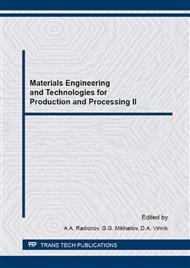[1]
R. Cobden, Alkan, Banbury, Aluminium: Physical Properties, Characteristics and Alloys, TALAT Lecture 1501, EAA - European Aluminium Association, (1994).
Google Scholar
[2]
K. Dudzik, Mechanical properties of 5083, 5059 and 7020 aluminium alloys and their joints welded by MIG, J. of KONES Powertrain and Transport. 18 (2011) 73-77.
DOI: 10.5604/12314005.1137318
Google Scholar
[3]
B.R. Spacht, The corrosion resistance of aluminum and its alloys, J. Chem. Educ. 23 (1946) 253.
Google Scholar
[4]
J.R. Davis, Corrosion of Aluminum and Aluminum Alloys, ASM International, (1999).
Google Scholar
[5]
B.E. Placzankis, General Corrosion Resistance Comparisons of Medium-and High-Strength Aluminum Alloys for DOD Systems Using Laboratory-Based Accelerated Corrosion Methods, Army Research Laboratory, Aberdeen Proving Ground, MD 21005-5066, (2009).
DOI: 10.21236/ada516812
Google Scholar
[6]
Aliminium and Corrosion, UK Aluminium Industry, Fact Sheet 2, (2014).
Google Scholar
[7]
J. Yue, Y. Cao, Corrosion Prevention by Applied Coatings on Aluminum Alloys in Corrosive Environments, Int. J. Electrochem. Sci. 10 (2015) 5222-5237.
DOI: 10.1016/s1452-3981(23)17250-6
Google Scholar
[8]
A.Y. Musa, Corrosion Protection of Al Alloys: Organic Coatings and Inhibitors, Recent Researches in Corrosion Evaluation and Protection, Materials Science: Biomaterials. (2012) 51-66.
DOI: 10.5772/31983
Google Scholar
[9]
S.V. Oleinik, Yu. I. Kuznetsov, Corrosion Inhibitors in Conversion Coatings, IV, J. Protection of Metals. 43 (2007) 391-397.
DOI: 10.1134/s0033173207040133
Google Scholar
[10]
A.L. Yerokhin, X. Nie, A. Leyland, A. Matthews, S.J. Dowey, Plasma electrolysis for surface engineering, J. Surface and Coatings Technology. 122 (1999) 73-93.
DOI: 10.1016/s0257-8972(99)00441-7
Google Scholar
[11]
R.H.U. Khan, A. Yerokhin, A. Matthews, X. Li, H. Dong, Surface characterization of dc plasma electrolytic oxidation treated 6082 aluminium alloy effect of current density and electrolyte concentration, J. Surface and Coatings Technology. 205 (2010).
DOI: 10.1016/j.surfcoat.2010.04.052
Google Scholar
[12]
H.X. Li, V.S. Rudnev, X.H. Zheng, T.P. Yarovaya, R.G. Song, Characterization of Al2O3 ceramic coatings on 6063 aluminium alloy prepared in borate electrolytes by micro arc oxidation, J. Journal of Alloys and Compounds. 462 (2008) 99-102.
DOI: 10.1016/j.jallcom.2007.08.046
Google Scholar
[13]
O. Young-Jun, M. Jung-II, K. Jung-Hwan, Effects of alloying elements on microstructure and protective properties of Al2O3 coatings formed on aluminium alloy substrates by plasma electrolysis, J. Surf & Coat Technol. 204 (2009) 141-148.
DOI: 10.1016/j.surfcoat.2009.07.002
Google Scholar
[14]
K. Tillous, T. Toll-Douchanoy, E. Bauer-Grosse, L. Hericher, G. Geandier, Microstructure and phase composition of micro arc oxidation surface layers formed on aluminium and its alloys 2214-T6 and 7050-T74, J. Surf. & Coat. Technol. 203 (2009).
DOI: 10.1016/j.surfcoat.2009.03.021
Google Scholar
[15]
E.S. Atroshchenko, O. E. Chufistov, I. A. Kazantsev, S. I. Kamyshanskii, Formation of structure and properties of coatings deposited by microarc oxidizing on parts fabricated from aluminum alloys, J. Metal Science and Heat Treatment. 42 (2000).
DOI: 10.1007/bf02725327
Google Scholar
[16]
B. Rajasekaran, S. Ganesh Sundara Raman, L. Rama Krishna, S.V. Joshi, G. Sundararajan, Influence of micro arc oxidation and hard anodizing on plain fatigue and fretting fatigue behaviour of Al−Mg−Si alloy, J. Surf & Coat Technol. 202 (2008).
DOI: 10.1016/j.surfcoat.2007.06.058
Google Scholar
[17]
K. Prasad Rao, G.D. Janaki Ram, B.E. Stucker, Improvement in corrosion resistance of friction stir welded aluminium alloys with micro arc oxidation coatings, J. Scripta Materialia. 58 (2008) 998-1001.
DOI: 10.1016/j.scriptamat.2008.01.033
Google Scholar
[18]
X. Wen-bin, W. Chao, T. Hua, L. Yong-chun, Corrosion behaviours and galvanic studies of micro arc oxidation films on Al-Zn-Mg-Cu alloys, J. Surf & Coat Technol. 201 (2007) 8695-8701.
DOI: 10.1016/j.surfcoat.2006.10.029
Google Scholar
[19]
D.T. Asquith, A.L. Yerokhin, J.R. Yates, A. Matthews, The effect of combined shot-peening and PEO treatment on the corrosion performance of 2024 aluminium alloy, J. ThinSolid Films. 516 (2007) 417-421.
DOI: 10.1016/j.tsf.2007.06.166
Google Scholar
[20]
M.M. Krishtal, Effect of Structure of Aluminum-Silicon Alloys on the Process of Formation and Characteristics of Oxide Layer in Microarc Oxidizing, J. Metal Science and Heat Treatment. 46 (2004) 377-384.
DOI: 10.1023/b:msat.0000049810.75325.f9
Google Scholar
[21]
S.К. Kiselyeva, L.I. Zaynullina, М.М. Abramova, N.Y. Dudareva, I.V. Alexandrov, The Effect of Microarc Oxidation (MAO) Modes on Corrosion Behavior of High-Silicon Aluminum Alloy, Journal of Engineering Science and Technology Review. 7 (2014).
DOI: 10.25103/jestr.075.10
Google Scholar
[22]
Information on http: /www. splav-kharkov. com.
Google Scholar
[23]
Iu.P. Adler, Planning of Experiment with Finding the Optimal Conditions, Moscow, Nauka. (1976).
Google Scholar
[24]
T. Wei, Characterization and wear- and corrosion-resistance of microarc oxidation ceramic coatings on aluminum alloy, J. Journal of Alloys and Compounds. 389 (2005) 169-176.
DOI: 10.1016/j.jallcom.2004.05.084
Google Scholar


